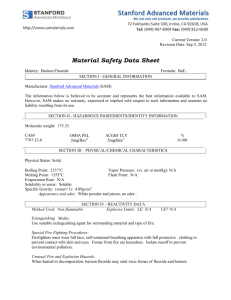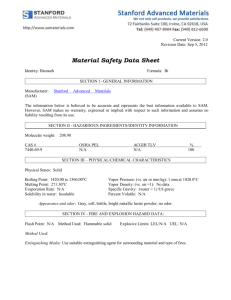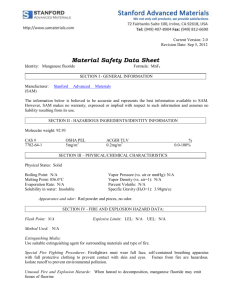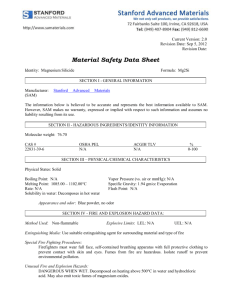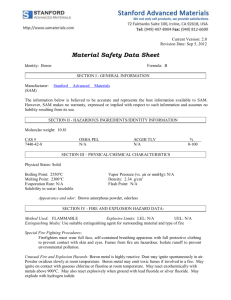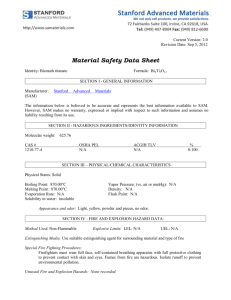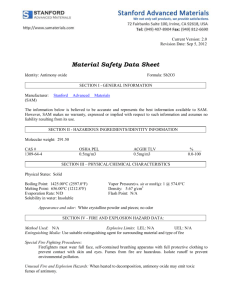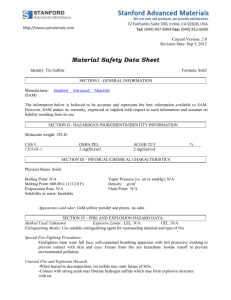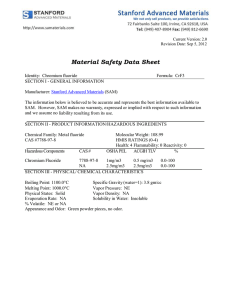Microsoft Word - CeF3 - Stanford Advanced Materials
advertisement
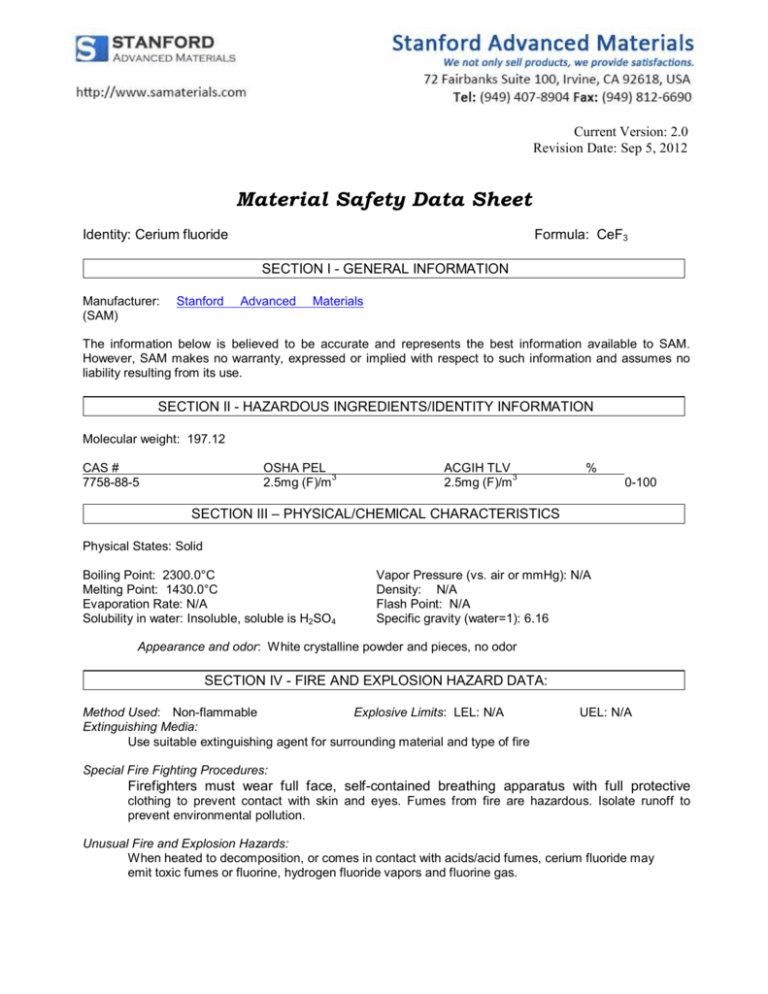
Current Version: 2.0 Revision Date: Sep 5, 2012 Material Safety Data Sheet Identity: Cerium fluoride Formula: CeF3 SECTION I - GENERAL INFORMATION Manufacturer: (SAM) Stanford Advanced Materials The information below is believed to be accurate and represents the best information available to SAM. However, SAM makes no warranty, expressed or implied with respect to such information and assumes no liability resulting from its use. SECTION II - HAZARDOUS INGREDIENTS/IDENTITY INFORMATION Molecular weight: 197.12 CAS # 7758-88-5 OSHA PEL 3 2.5mg (F)/m ACGIH TLV 3 2.5mg (F)/m % 0-100 SECTION III – PHYSICAL/CHEMICAL CHARACTERISTICS Physical States: Solid Boiling Point: 2300.0°C Melting Point: 1430.0°C Evaporation Rate: N/A Solubility in water: Insoluble, soluble is H2SO4 Vapor Pressure (vs. air or mmHg): N/A Density: N/A Flash Point: N/A Specific gravity (water=1): 6.16 Appearance and odor: White crystalline powder and pieces, no odor SECTION IV - FIRE AND EXPLOSION HAZARD DATA: Method Used: Non-flammable Explosive Limits: LEL: N/A Extinguishing Media: Use suitable extinguishing agent for surrounding material and type of fire UEL: N/A Special Fire Fighting Procedures: Firefighters must wear full face, self-contained breathing apparatus with full protective clothing to prevent contact with skin and eyes. Fumes from fire are hazardous. Isolate runoff to prevent environmental pollution. Unusual Fire and Explosion Hazards: When heated to decomposition, or comes in contact with acids/acid fumes, cerium fluoride may emit toxic fumes or fluorine, hydrogen fluoride vapors and fluorine gas. SECTION V - REACTIVITY DATA Stability: Stable Conditions to Avoid (stability): None Incompatibility: Hazardous Decomposition or Byproducts: Fumes of fluorine, hydrogen fluoride, fluorine gas and cerium oxide Hazardous Polymerization: Will not occur Conditions to avoid (hazardous polymerization): None SECTION VI - HEALTH HAZARD DATA Routes of entry: Inhalation? Yes Skin? Yes Eyes? Yes Ingestion? Yes Other? N Signs and Symptoms of Overexposure: Inhalation: Sclerosis of the bones, calcification of ligaments, mottled teeth, osteosclerosis, ostemalacia, loss of weight, anorexia, anemia, wasting, cachia and dental defects Ingestion: May cause nausea, vomiting, diarrhea, abdominal burning and cramp-like pain Skin: May cause redness, itching and burning Eye: May cause redness, itching, burning and watering Health Hazards (Acute and Chronic): Cerium is considered a rare earth metal. These metals are moderately to high toxic. The symptoms of toxicity of the rare earth elements include writhing, ataxia, labored respiration, walking on the toes with arched back and sedation. The rare earth elements exhibit low toxicity by ingestion exposure. Inorganic fluorides are, in general, highly irritating and toxic. Chronic fluorine poisoning occurs among minors or cryolite. There may also be some calcification of the ligaments. Some enzyme system effects have been reported. (Sax, Dangerous Properties of Industrial Materials, eighth edition) Inhalation: Acute: May cause irritation to the respiratory tract and mucous membranes. Dusts may cause asthma attacks and lung damage such as lung granulomas and pulmonary edema. Large doses may cause immediate defecation, writhing, loss of muscle coordination, labored respiration, sedation, hypotension, dyspnea, hyperemia, liver edema and necrosis, portal congestion, pleural effusion, and granulomatous peritonitis with serous and hemorrhagic ascites, respiratory and cardiac failure. Chronic: May cause fluorine poisoning, pulmonary fibrosis, sever bone changes, hyperemia, cellular eosinophilia and vascular granulomata, acute chemical pneumonitis, sub acute bronchitis and focal hyper tropic emphysema Ingestion: Acute: May cause gastrointestinal irritation Chronic: May affect the coagulation rate of the blood, renal and hepatic functions, circulatory, enzyme and nervous system. Skin: Acute: May cause irritation, rashes and skin granulomas Chronic: May cause dermatitis, sensitivity to heat, itching and skin lesions Eye: Acute: May cause irritation Chronic: No chronic health effects recorded Target Organs: Skeleton, kidneys, central nervous system, respiratory system, and skin Carcinogenicity: NTP? No IARC Monographs? No OSHA Regulated? No Medical Conditions Aggravated by Exposure: Pre-existing respiratory disorders Emergency and First Aid Procedures: Inhalation: Remove victim to fresh air, keep warm and quiet, and give oxygen if breathing is difficult; seek medical attention Ingestion: Give 1-2 glasses of milk or water and induce vomiting, seek medical attention. Never induce vomiting or give anything by mouth to an unconscious person Skin: Remove contaminated clothing, brush material off skin, wash affected area with mild soap and water, and seek medical attention if symptoms persist Eye: Flush eyes with lukewarm water, lifting upper and lower eyelids for at least 15 minutes and seek medical attention SECTION VII - PRECAUTIONS FOR SAFE HANDLING AND USE Steps to be taken in case material is released or spilled: Wear appropriate respiratory and protective equipment specified in section VIII. Isolate spill area, provide ventilation and extinguish sources of ignition. Vacuum up spill using a high efficiency particulate absolute (HEPA) air filter and place in a closed container for proper disposal. Take care not to raise dust. Waste disposal method: Dispose of in accordance with state, local, and federal regulations. Hazard Label Information: Store in cool, dry area and in tightly sealed container. Wash thoroughly after handling. SECTION VIII - CONTROL MEASURES Protective Equipment Summary (Hazard Label Information): NIOSH approved respirator, impervious Neoprene, PVC or butyl gloves, safety glasses, clothes to prevent contact. Ventilation: Local Exhaust: To maintain concentration at low exposure levels. Mechanical (General): Recommended. Work/Hygienic/Maintenance Practices: Implement engineering and work practice controls to reduce and maintain concentration of exposure at low levels. Use good housekeeping and sanitation practices. Do not use tobacco or food in work area. Wash thoroughly before eating or smoking. Do not blow dust off clothing or skin with compressed air. Please be advised that N/A can either mean Not Applicable or No Data Has Been Established
